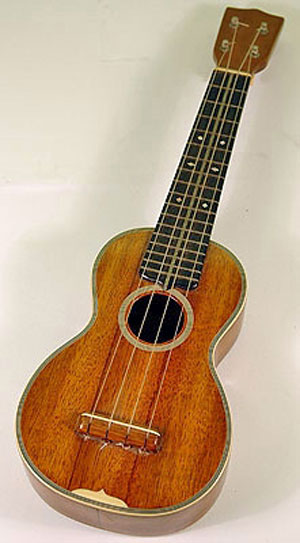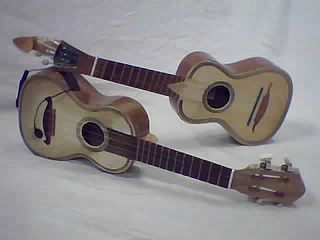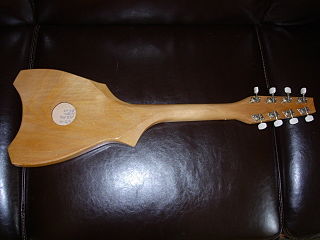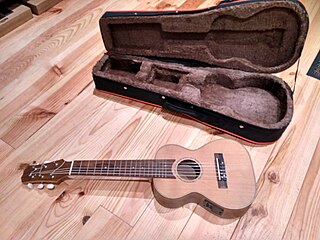Related Research Articles

Madeira, officially the Autonomous Region of Madeira, is one of two autonomous regions of Portugal, the other being the Azores. It is an archipelago situated in the North Atlantic Ocean, in a region known as Macaronesia, just under 400 kilometres (250 mi) to the north of the Canary Islands and 520 kilometres (320 mi) west of the Kingdom of Morocco. Madeira is geologically located on the African Tectonic Plate, although it is culturally, politically and ethnically associated with Europe, with its population predominantly descended from original Portuguese settlers. Its population was 251,060 in 2021. The capital of Madeira is Funchal, which is located on the main island's south coast.

The ukulele, also called a uke, is a member of the lute family of instruments of Portuguese origin and popularized in Hawaii. It generally employs four nylon strings.
The music of Hawaii includes an array of traditional and popular styles, ranging from native Hawaiian folk music to modern rock and hip hop. Styles like slack-key guitar are well known worldwide, while Hawaiian-tinged music is a frequent part of Hollywood soundtracks. Hawaii also made a contribution to country music with the introduction of the steel guitar. In addition, the music which began to be played by Puerto Ricans in Hawaii in the early 1900s is called cachi cachi music, on the islands of Hawaii.

The banjo ukulele, also known as the banjolele or banjo uke, is a four-stringed musical instrument with a small banjo-type body and a fretted ukulele neck. The earliest known banjoleles were built by John A. Bolander and by Alvin D. Keech, both in 1917.

The cavaquinho is a small Portuguese string instrument in the European guitar family, with four wires or gut strings.

A tiple, is a plucked typically 12-string chordophone of the guitar family. A tiple player is called a tiplista. The first mention of the tiple comes from musicologist Pablo Minguet e Irol in 1752. Although many variations of the instrument exist, the tiple is mostly associated with Colombia, and is considered the national instrument. The Puerto Rican version characteristically has fewer strings, as do variants from Cuba, Mallorca, and elsewhere among countries of Hispanic origin.
The cuatro is a family of Latin American string instruments played in Colombia, Puerto Rico, Venezuela and other Latin American countries. It is derived from the Spanish guitar. Although some have viola-like shapes, most cuatros resemble a small to mid-sized classical guitar. In Puerto Rico and Venezuela, the cuatro is an ensemble instrument for secular and religious music, and is played at parties and traditional gatherings.

Kroncong is the name of a ukulele-like instrument and an Indonesian musical style that typically makes use of the kroncong. A kroncong orchestra or ensemble traditionally consists of a flute, a violin, at least one, but usually a pair of kroncongs, a cello in Pizzicato style, string bass in pizzicato style, and a vocalist. Kroncong originated as an adaptation of a Portuguese musical tradition, brought by sailors to Indonesian port cities in the 16th century. By the late 19th century, kroncong reached popular music status throughout the Indonesian archipelago.

On a stringed instrument, a break in an otherwise ascending order of string pitches is known as a re-entry. A re-entrant tuning, therefore, is a tuning which does not order all the strings from the lowest pitch to the highest pitch.

The Tahitian ukulele is a short-necked fretted lute with eight nylon strings in four doubled courses, native to Tahiti and played in other regions of Polynesia. This variant of the older Hawaiian ukulele is noted by a higher and thinner sound and an open back, and is often strummed much faster.

A guitalele, also called a ukitar, or kīkū, is a guitar-ukulele hybrid, that is, "a 1/4 size" guitar, a cross between a classical guitar and a tenor or baritone ukulele. The guitalele combines the portability of a ukulele, due to its small size, with the six single strings and resultant chord possibilities of a classical guitar. It may include a built-in microphone that permits playing the guitalele either as an acoustic guitar or connected to an amplifier. The guitalele is variously marketed as a travel guitar or children's guitar. It is essentially a modern iteration of the Quint guitar.

The Music of Madeira reflects its cultural heritage, this can be seen in the local folklore music, which in Madeira is widespread and mainly uses local musical instruments such as the machete, rajão, brinquinho and cavaquinho, which are used in traditional folkloric dances like the bailinho da Madeira.

The rajão is a 5-stringed instrument from Madeira, Portugal. The instrument traces back to the country's regional folk music, where it is used in folklore dances of Portugal in addition to other stringed instruments from the same region.

Viola braguesa is a stringed instrument from Braga, north-western Portugal. It has 10 strings in 5 courses. The strings are made of steel. It is tuned C4/C3–G4/G3–A4/A3–D4/D4–G4/G4. The scale length is about 500 mm (20 inches).
The viola da Terceira is a stringed musical instrument of the guitar family, from the Portuguese islands of the archipelago of the Azores, associated with the island of Terceira.
Portuguese immigration to Hawaii began in 1878 when laborers from Madeira and the Azores migrated there to work in the sugarcane plantations. By the end of 1911, nearly 16,000 Portuguese immigrants had arrived.

Missas do Parto are one of the greatest Christmas traditions of the Autonomous Region of Madeira in Portugal. They consist of nine masses celebrated in the novena before Christmas Day - from 16 to 24 December - in all the parishes of the Autonomous Region, at the end of the morning. They are a Marian devotion and celebrate the pregnancy of the Virgin Mary, in the figure of Our Lady of Ó who, in Madeira, is called Our Lady of Birth. After the Masses of the Childbirth there follows the Mass of the Rooster, on the night of 24 December.
References
- ↑ Ruymar, Lorene (1 September 1996). The Hawaiian Steel Guitar and Its Great Hawaiian Musicians. Centerstream Publications. p. 10. ISBN 978-1-57424-021-4 . Retrieved 21 August 2012.